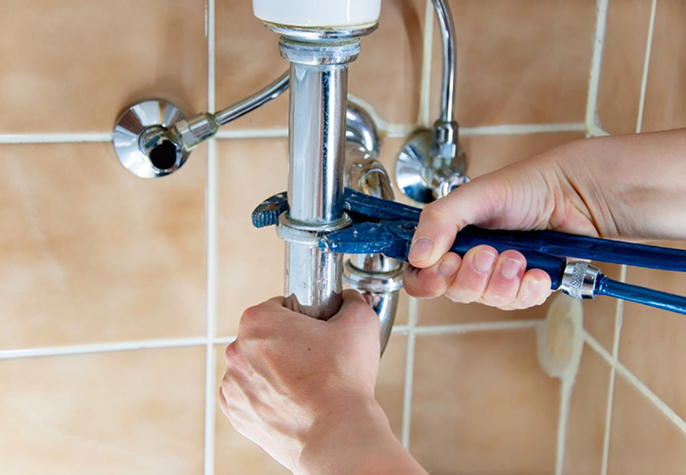
No matter how well you maintain your home, or how high-end your fixtures are, there’s a good chance a home plumbing issue is in your future. Wear and tear eventually lead to a number of minor issues that don’t only affect the quality of your home plumbing, but can lead to much larger and more expensive issues if not addressed. Can you handle the repair yourself? We at Madsen are happy to help our clients with any home plumbing issue they have, but yes, many common issues are simple enough to be fixed by a seasoned DIYer. Check out the five most common home plumbing issues and how to know if you and your toolbox are up for the challenge or not.
- Clogged drains
Clogged drains can occur in any room of the house and can be triggered by a variety of obstructions, from hair in the shower drain to food scraps in the kitchen. Your first line of defense is a plunger, which will suction blockages close to the surface so you can remove them. To break up a stubborn clog, try pouring a mixture of boiling water, vinegar, and a touch of baking soda down the drain.
If you’re thinking about purchasing a chemical drain cleaner from your local home improvement store, beware. Not all cleaners are created equal. Make sure to read the label before use, so you know you have the right product for your system.
If your clog goes deeper, many home improvement stores sell and rent a variety of snakes and augers that can go further into the pipes to reach bigger issues. We suggest you only use these yourself if you know what the clogged item is and are comfortable handling the equipment, particularly if you opt for an electric model. If not, our technicians can quickly come out, access the clog, and use the appropriate tool to free it.
If you do not know the location of your clog or it is impacting multiple items in your home plumbing system (i.e. all sinks or both the toilet and the shower), call a professional, as your issue may lie much deeper with a compromised sewer drain.
- Leaky faucets
The slow drip of a leaky faucet can drive you crazy, especially when you can’t figure out a way to stop it. These leaks can also waste as much as three gallons of water a day, so addressing the issue is important.
Most leaky faucets simply need one of two internal components replaced – the cam and packing or the seat and springs. You can shut off your water supply to the sink in question, run the faucet to let any remaining water in the lines out, and then remove the handles and begin taking apart the faucet. Be sure to also check all seals and O rings that look ripped or worn when replacing the offending parts. If you can’t tell which parts are causing the leak, many manufacturers sell internal replacement kits; upgrading all the pieces will no doubt fix the issue.
If the idea of disemboweling your faucet seems too much to handle, our techs can quickly access, clean, and replace parts in yours for you.
- Running toilets
When jiggling the handle doesn’t stop your toilets incessant running, it’s time to look under the hood – or in the tank, that is. Most running toilets are encountering an issue with the flapper or flush valve.
The easiest way to diagnosis your toilet trouble is by catching it in the act. The next time it’s running, lift the tank cover and see what’s going on. If the tank is not filling, close the flapper manually, and be sure the chain isn’t getting caught on anything to prohibit the flapper from staying closed. If the water appears high, the float may be set to go too high, which will increase pressure and force water into the bowl continuously. Adjust it so the water level is lower, about an inch below the overflow tube. If any of the components are broken or have faulty seals, your local home improvement store sells replacement sets that are easy to install.
- Leaking pipes
Leaking pipes can cause expensive damage if not addressed quickly. First things first: shut off the water. Flush the remaining water from the line and clean up any leaked water, allowing everything to dry.
If the leak is small or at a pipe fitting, many knowledgeable DIYers can handle the repair. This would include sealing with epoxy, rubber, and a clamp if mid-pipe, or resealing or replacing the fitting.
If the leak is large, though, a section of pipe will need to be replaced – a job that can get complicated and include soldering depending on the type of pipe in question. Because a small crack can turn into a major issue in the wrong hands, we highly suggest homeowners contact a professional at this point.
- Low water pressure
Low pressure can do more than ruin a relaxing shower – it can be the sign of deeper issues in your home’s plumbing.
If it’s only one fixture in your home experiencing the pressure issue, it may be a clogged aerator. Clean the figure with vinegar or a descaling solution to remove mineral build-up that could be blocking water and air.
Be sure all your shut-off valves, including the one on your hot water heater, are completely open. A small adjustment can make a big difference.
Look for leaks around your home that could be seeping water and creating the low pressure.
If these checks do not turn up the culprit, your issue may be a service line leak, a hot water heater issue, or a broken piece like the pressure reducing valve. A professional plumber like the highly trained techs at Madsen can help you find the exact issue and mange any repairs and replacements to ensure your entire home plumbing system is working properly, and that your next shower hits the spot.


